There are several common diseases of goldfish (Carassius auratus) and koi (Cyprinus carpio var.) which can be recognised and treated successfully by the farmer with some veterinary assistance. These notes also apply to the same diseases in other ornamental fish species.
Gill diseases
Fish with parasites, bacteria or blockages of the gills will distend their gill and cause them to breathe more rapidly than normal to obtain oxygen, before dying. Low levels of dissolved oxygen in the water, in contrast, usually cause the fish to sip repeatedly at the surface.
Careful examination of a few sick or very recently dead fish will help identify the cause. If well-defined segments of the normally red gills are white or off-white and slimy, the most likely cause is bacterial gill disease.
This is due to an overgrowth of common water bacteria and flexibacteria, which usually occurs following cold snaps or temperature stress, and in crowded unhygienic conditions. These stressful conditions should be remedied, then the fish can be treated using medication available from pet shops specialising in fish.
Should the gills appear more normal but perhaps slimy or blotchy, microscopic parasites are the most likely case. These include the microscopic protozoans Costia, Chilodonella and Trichodina.
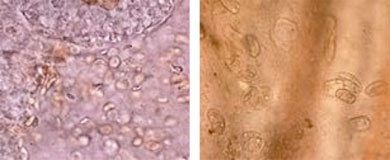
Costia (left) and Chilodonella (right).
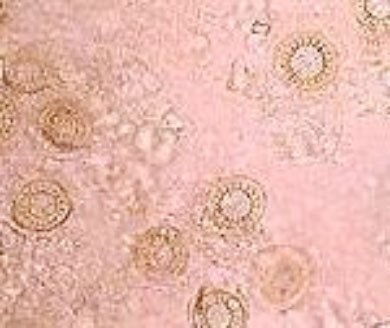
An example of Trichodina.
Gill flukes are highly active 0.5 - 1.5 mm flatworms. They are just visible with a hand lens if affected gill slime is scraped on to a piece of glass and examined carefully in good light.
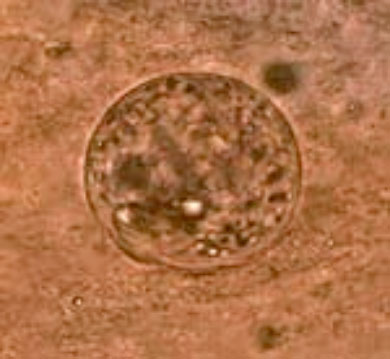
A magnified example of Whitespot.
‘Whitespot’ or ‘ich’ disease is due to the protozoan, Ichthyophthirius multifiliis, which forms visible white spots or bumps in the skin and gills. Treatment with proprietary chemicals will kill ‘ich’ but only after the spots hatch out, so treatment must be repeated twice-weekly until no white spots have been seen for at least a week.
Skin diseases
Two crustacean parasites are common and problematic, the anchor ‘worm’ Lernaea and the fish ‘louse’ Argulus. Adult female Lernaea look like a piece of heavy nylon fishing line, about 1 cm long, protruding from the skin, sometimes with two egg sacs visible on the end.
Treatment kills only the free-swimming larvae released from the eggs, so must be repeated weekly until all the adults have disappeared off the fish and for three weeks thereafter.
New fish should be quarantined for at least three weeks at 25 degrees Celsius and watched for emergence of the adults. Quarantine of new rocks, plants and water for one week in the absence of fish will ensure the death of any larvae.
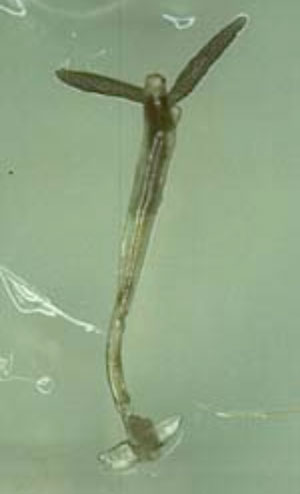
A magnified example of a Lernaea.
A magnified example of an Argulus.
Argulus is a two to four millimetre flat louse-like crustacean, which scurries over the skin and into hiding when fish are handled for examination.
New fish should be quarantined for at least two weeks before introduction. The only sure way to keep Argulus out of the farm is to only bring in fish, rocks, plants and water from disease-free sources, as the eggs can survive for up to two months.
Another skin disease that can only be avoided by using disease-free sources is Goldfish Ulcer Disease. This is due to a bacterium, Aeromonas salmonicida, and is well known as whitish raised patches on the skin which progress to ugly, ragged, red ulcers. It is considered exotic to Western Australia.
Affected fish should be removed and destroyed as there is no effective treatment, but never sold or released to ponds or rivers as the disease is dangerous for many fish including trout. The disease is notifiable in Western Australia so fish must be purchased only from sources free of goldfish ulcer disease, and any suspicious ulcerative disease occurrences must be reported to the nearest Department of Agriculture office within 24 hours.
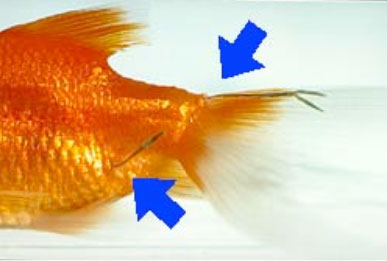
An example of a attached Lernaea.
Goldfish also sometimes develop coloured lumps on the skin. These are usually relatively harmless tumours known as fibromas, but are unsightly. They can be removed with a sterile scalpel blade if the fish is anaesthetised with ‘Aqui-S’* and placed on a soft wet surface. Carp ‘pox’ is a virus infection characterised by soft white lumps on the skin which reappear if excised, but is less common.
Fluke infestations of the skin, as well as the gills, are common. Heavily infested fish appear pale and slimy with red spots or patches in the skin, and may scratch against rocks or tank walls (‘flashing’). Treatment is as for gill flukes.
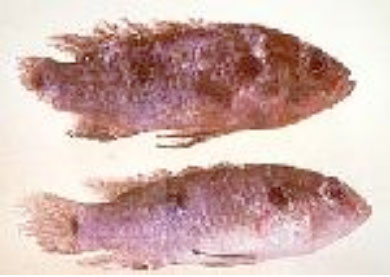
An example of tail rot.
Fin and tail rot are well known to fish breeders, and similar to bacterial gill disease; the treatment is also the same (see above).
The protozoan parasites affecting gills will also be found on the skin if a scraping of skin slime is examined under a good microscope; again the fish may show ‘flashing’ behaviour.
Internal parasites
The most common is the koi tapeworm, Bothriocephalus acheilognathi, a long, fine, white ribbon-like worm found in tangled masses in the intestine. These are easily recognised if affected fish are dissected.
Heavily infested fish lose condition and can suffer intestinal blockage. Treatment can be safely carried out before the fish reach this stage. Worm tablets are available from pet shops. It is important to follow the instructions on the label.
Goldfish are rarely seriously infected, but koi fry should be treated once or twice during rearing before sale if the tapeworm is known to occur on the farm. The worm will re-appear in the fish because it is transmitted by tiny crustaceans living in the ponds, but only heavy infestations are of concern.
Other diseases
Less common diseases which can be harder to treat, will occur from time to time. Veterinary advice should be obtained where the disease cannot be solved using the above methods. These include ’dropsy’ where the abdomen fills with fluid, often due to bacterial infection.
Another cause of dropsy which is often overlooked is kidney bloater disease, due to a protozoan called Hoferellus (Mitraspora) infecting the kidney. Koi farmers sometimes speak of 'sleeping sickness' but this protozoan blood disease has not been confirmed by laboratory testing.
Recently ‘goldfish cyprinid herpesvirus 2’ has entered WA and caused mortalities among goldfish. The virus causes damage to the liver, spleen and kidney of affected fish, resulting in high mortality. The disease is untreatable. The virus does not affect carp. A related herpesvirus (koi herpesvirus) is exotic to Australia.
Prevention of diseases
The first step is to quarantine new fish and screen them for the diseases described above, before introducing them to the main farm ponds. Obtain stocks from farms free of goldfish ulcer disease, Argulus and Lernaea in particular. Try and remove parasites by treatment during quarantine. A quarantine period of at least three weeks is advisable.
Good husbandry is vital in maintaining the fish free of diseases. Avoid high stocking rates and unhygienic conditions due to fouling with food, faeces, dead fish and algae. Reduce temperature shocks and fluctuations. Inspect fish regularly and treat for parasites before they get out of hand.
* Reference to trade names does not imply our endorsement, other products may be equally suitable. Products which are registered in Western Australia for use in ornamental fish were selected for this document.
Please note: We are unable to provide diagnostic advice by email.